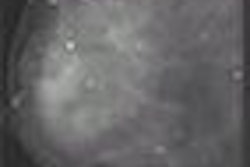
Computer-aided detection (CAD) can lead to higher breast cancer detection rates, a younger age at diagnosis, and a significantly earlier stage of invasive cancer at detection, according to research published in the October issue of the American Journal of Roentgenology.
"Our findings support the hypothesis that screening with CAD significantly improves detection of the specific cancer morphologies that CAD algorithms were designed to detect," wrote a research team led by Dr. Tommy Cupples of the South Carolina Comprehensive Breast Center at Palmetto Richland Memorial Hospital in Columbia, SC.
To prospectively evaluate the effect of CAD on screening outcomes in a regional mammography program, the researchers performed 27,274 consecutive screening mammograms between January 1, 1998, and December 31, 2000. The performances of radiologists both before and with CAD were reviewed (AJR, October 2005, Vol. 185:4, pp. 944-950).
Of the 27,274 examinations, 7,872 were conducted in 1998 before CAD was installed, with the remaining exams conducted in the following two years with CAD. All mammograms were performed using Mammomat 3000 or Nova 3000 mammography systems (Siemens Medical Solutions, Malvern, PA).
For the CAD group, standard views (craniocaudal and mediolateral oblique) were analyzed by the ImageChecker M1000 CAD system, version 2.0 (R2 Technology, Sunnyvale, CA), using a CAD processing unit and a separate CAD display unit.
Three experienced radiologists participated in the screening program during both the pre-CAD and CAD periods. The research team obtained pathology reports of core needle biopsy and/or surgical biopsy histopathology for all cancers included in the study.
The use of CAD increased cancer detection rate by 16.1% (from 3.7 to 4.3 per 1,000 cases). The researchers also found that the detection rate of invasive cancers less than or equal to 1 cm increased 164% (from 0.508 to 1.34 per 1,000 exams). Detection rates of in situ cancers declined 6.7% (from 1.27 to 1.19 per 1,000 studies).
In other findings, the mean age of patients with screening-detected breast cancer with CAD was 59.5 years, 5.3 years younger than the average age of diagnosis in the pre-CAD group.
The researchers noted the most substantial changes experienced with CAD were within the subgroup of invasive cancers, with proportionate increases occurring with an in situ component (116% increase), stage I cancers (72% increase), and invasive cancers less than or equal to 1.0 cm (112% increase). Increase in prevalent cancers was 26%.
"When these characteristics were combined with age at diagnosis in logistic regression analysis, the strongest and most significant predictor for improved screening outcomes with CAD was early stage invasive cancer (stage I versus stage II or higher; odds ratio 4.13; p = 0.025," the authors wrote.
While the overall recall rate increased 8.1% (from 7.69 to 8.31) and the biopsy rate increased 6.69% (from 1.37 to 1.46) with the use of CAD, both were well below the 16.1% increase in cancers detected, according to the authors. The positive biopsy rate increased 8.84% (from 26.9 to 29.2).
The authors noted limitations in their study, including the large sample sizes required to detect statistically significant changes in a screening population and potential inherent differences in pre- and post-CAD populations, a lack of agreement on the definition of a screening mammogram, and possible staging errors.
In conclusion, the researchers pointed to the 16.1% increase in the cancer detection rate, which did not come at the expense of a discordant increase in the screening recall rate or biopsy rate. Also, the substantial increases in the proportion of early stage invasive cancers and younger patient age at diagnosis with CAD were clinically and statistically significant, according to the study team.
"These findings affirm the benefit of CAD in our regional mammography program," the group wrote.
By Erik L. Ridley
AuntMinnie.com staff writer
October 5, 2005
Related Reading
Jury is still out on U.K. CAD utilization, October 4, 2005
Computer-aided detection system helps diagnose breast cancer, September 6, 2005
Despite flaws, lung CAD earns second-reader role, September 5, 2005
CAD marks: To save or not to save? September 1, 2005
Management strategies evolve as CT finds more lung nodules, August 19, 2005
Part II: Computer-aided detection identifying new targets, July 15, 2005
Copyright © 2005 AuntMinnie.com



















